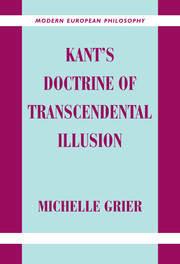Book contents
- Frontmatter
- Contents
- Acknowledgments
- Note on References and Translations
- Introduction
- PART ONE KANT'S DISCOVERY OF METAPHYSICAL ILLUSION
- PART TWO FALLACIES AND ILLUSIONS IN THE CRITIQUE OF PURE REASON
- PART THREE THE DIALECTICAL INFERENCES OF PURE REASON
- 5 Rational Psychology and the Pseudorational Idea of the Soul
- 6 Rational Cosmology and the Pseudoempirical Idea of the World
- 7 Rational Theology and the Pseudorational Idea of God
- PART FOUR ILLUSION AND SYSTEMATICITY
- Conclusion
- Selected Bibligraphy
- Index
6 - Rational Cosmology and the Pseudoempirical Idea of the World
Published online by Cambridge University Press: 30 September 2009
- Frontmatter
- Contents
- Acknowledgments
- Note on References and Translations
- Introduction
- PART ONE KANT'S DISCOVERY OF METAPHYSICAL ILLUSION
- PART TWO FALLACIES AND ILLUSIONS IN THE CRITIQUE OF PURE REASON
- PART THREE THE DIALECTICAL INFERENCES OF PURE REASON
- 5 Rational Psychology and the Pseudorational Idea of the Soul
- 6 Rational Cosmology and the Pseudoempirical Idea of the World
- 7 Rational Theology and the Pseudorational Idea of God
- PART FOUR ILLUSION AND SYSTEMATICITY
- Conclusion
- Selected Bibligraphy
- Index
Summary
At A406/B433 Kant outlines the particular type of dialectical argument, one that has as its content “the unconditioned unity of the objective conditions in the field of appearance.” Such an argument grounds what Kant calls the Antinomy of Pure Reason, and the problem is said to be that it commits the fallacy of the ambiguous middle (sophisma figurae dictionis, A500/B528). This suggestion may seem strange, for the antinomies, unlike the paralogisms and the ideal, are not supposed to offer us a clear case of formally invalid argumentation. After all, the defining characteristic of the antinomial conflict (and presumably that very aspect which roused Kant from his dogmatic slumber) is the successful nature of the cosmological arguments. Not only do they not suffer from any internal inconsistency but, according to Kant, each side to the various disputes succeeds in refuting the position of the other.
Kant's account is complicated by the fact that he claims that the general conflict of reason with itself gives rise to two different sets of antinomial confrontations. Both the diagnoses of the errors and their resolutions differ in the two cases. The first set of confrontations are referred to as “mathematical” antinomies. As with all the antinomies, each of the conflicts articulates a debate between two historically opposed positions as regards the nature and constitution of the “world.”
- Type
- Chapter
- Information
- Kant's Doctrine of Transcendental Illusion , pp. 172 - 229Publisher: Cambridge University PressPrint publication year: 2001



